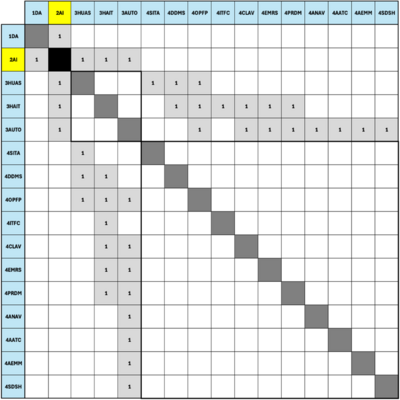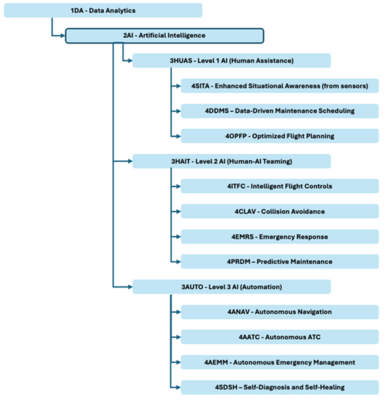Difference between revisions of "AI Safety Aviation"
m (Removed comments from bottom of page) |
(Updated formulas for better display) |
||
| Line 25: | Line 25: | ||
|| Rate of incidents and accidents normalized by flight time aircraft | || Rate of incidents and accidents normalized by flight time aircraft | ||
|| | || | ||
|| incidents/ | || | ||
<html> | |||
<math> | |||
<mfrac> | |||
<mrow> <mtext>incidents</mtext> </mrow> | |||
<mtext>passenger mile</mtext> | |||
</mfrac> | |||
</math> | |||
</html> | |||
|- | |- | ||
| System Maintainability | | System Maintainability | ||
|| How easy it is to maintain the aircraft systems, measured by comparing maintenance time per flight time | || How easy it is to maintain the aircraft systems, measured by comparing maintenance time per flight time | ||
|| | || | ||
|| | || | ||
<html> | |||
<math> | |||
<mfrac> | |||
<mrow> <mtext>maintenance hours</mtext> </mrow> | |||
<mtext>passenger mile</mtext> | |||
</mfrac> | |||
</math> | |||
</html> | |||
|- | |- | ||
| System Ease of Operation | | System Ease of Operation | ||
|| Measure how easy it is to operate the aircraft by comparing number of personnel required to operate a vehicle per flight hour | || Measure how easy it is to operate the aircraft by comparing number of personnel required to operate a vehicle per flight hour | ||
|| | || | ||
|| | || | ||
<html> | |||
<math> | |||
<mfrac> | |||
<mrow> <mtext># of personnel</mtext> </mrow> | |||
<mtext>passenger mile</mtext> | |||
</mfrac> | |||
</math> | |||
</html> | |||
|- | |- | ||
| Response Time | | Response Time | ||
|| Time required to identify and mitigate safety issues | || Time required to identify and mitigate safety issues | ||
|| | || | ||
|| minutes | || | ||
<html> | |||
<math> | |||
<mtext>minutes</mtext> | |||
</math> | |||
</html> | |||
|- | |- | ||
| System Uptime | | System Uptime | ||
|| Amount of time aircraft is available to be dispatched on a mission as a percentage of wall time | || Amount of time aircraft is available to be dispatched on a mission as a percentage of wall time | ||
|| | || | ||
|| % | || | ||
<html> | |||
<math> | |||
<mtext>%</mtext> | |||
</math> | |||
</html> | |||
|- | |- | ||
| Cognitive Load on Crew | | Cognitive Load on Crew | ||
|| As measured by industry standard NASA TLX score | || As measured by industry standard NASA TLX score | ||
|| | || | ||
|| unitless | || | ||
<html> | |||
<math> | |||
<mtext>unitless</mtext> | |||
</math> | |||
</html> | |||
|- | |- | ||
|} | |} | ||
Revision as of 23:06, 9 October 2024
Roadmap Overview
Focuses on the integration of artificial intelligence, particularly machine learning, into safety-critical aviation systems while maintaining the highest standards of safety and trustworthiness. It encompasses a phased approach, starting with human assistance/augmentation (Level 1 AI), progressing to human-AI teaming (Level 2 AI), and ultimately advancing to more automated solutions (Level 3 AI). Key aspects include developing AI assurance frameworks, addressing human factors in AI integration, implementing safety risk mitigation strategies, and ensuring compliance with evolving regulatory requirements. This technology aims to enhance aviation safety, efficiency, and performance across various domains including aircraft design and operation, air traffic management, and unmanned aircraft systems.
DSM Allocation
Roadmap Model
Figures of Merit
| Figure of Merit | Description | Trends | Units |
|---|---|---|---|
| Incident Rate | Rate of incidents and accidents normalized by flight time aircraft |
| |
| System Maintainability | How easy it is to maintain the aircraft systems, measured by comparing maintenance time per flight time |
| |
| System Ease of Operation | Measure how easy it is to operate the aircraft by comparing number of personnel required to operate a vehicle per flight hour |
| |
| Response Time | Time required to identify and mitigate safety issues |
| |
| System Uptime | Amount of time aircraft is available to be dispatched on a mission as a percentage of wall time |
| |
| Cognitive Load on Crew | As measured by industry standard NASA TLX score |
|

